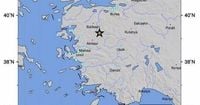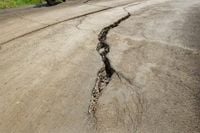Western Turkey was rocked late Monday night by a powerful earthquake, sending tremors across several provinces, toppling buildings, and leaving dozens injured but, remarkably, causing no immediate fatalities. The magnitude 6.1 quake struck at 10:48 p.m. local time (1948 GMT) on October 28, 2025, with its epicenter in the town of Sindirgi, Balikesir province, according to the Disaster and Emergency Management Authority (AFAD) and the United States Geological Survey. The quake’s shallow depth—measured at approximately 6 kilometers (3.7 miles)—amplified its effects, and aftershocks continued to unsettle the region throughout the night.
Residents of Sindirgi and surrounding areas, including Istanbul, Bursa, Manisa, and Izmir, felt the earth shake—a jarring reminder of Turkey’s vulnerability to seismic activity. According to The New York Times, the shaking was classified from light to severe on the Modified Mercalli Intensity scale, with the most intense tremors closest to the epicenter. Security footage from Manisa captured street lamps swaying, pool water sloshing, and products tumbling from shop shelves as the quake hit. In Istanbul, people rushed out of their homes, reporting swaying furniture and visibly distressed pets.
In the immediate aftermath, chaos and fear gripped many communities. Balikesir Governor Ismail Ustaoglu reported that 22 people were injured, mostly from falls or panic-induced jumps from balconies during the quake. "Eighteen people who jumped from balconies in panic sustained minor injuries," Ustaoglu said, as cited by multiple Turkish outlets. The injuries, while not life-threatening, underscored the psychological toll earthquakes inflict on those caught in their path.
Remarkably, no deaths were reported—a fortunate outcome attributed in part to recent preparedness measures. Sindirgi’s district administrator, Dogukan Koyuncu, told the state-run Anadolu Agency, “So far, we have not identified any loss of life, but we are continuing our assessment.” Turkish officials quickly launched comprehensive search operations across rural areas, ensuring that remote communities were not overlooked. These systematic checks, standard procedure following major quakes, reflect lessons learned from Turkey’s history of delayed casualty discoveries in isolated regions.
Structural damage, however, was significant. Interior Minister Ali Yerlikaya confirmed that at least three unoccupied buildings and a two-story shop, all previously damaged by earlier earthquakes, collapsed in Sindirgi. The district governor explained that three of the collapsed structures had been evacuated following prior tremors, and the fourth—a commercial store—was empty at the time of the quake. This fortunate timing likely prevented a much more tragic outcome. "Immediately after the earthquake, our citizens, who were rightfully fearful and anxious, did not want to return to their homes," Yerlikaya said during a visit to Balikesir.
Many residents, unwilling to risk further aftershocks, spent the night outdoors despite heavy rain. Local authorities responded by opening mosques, schools, and sports halls as emergency shelters. To further support displaced residents, the government dispatched 100 temporary housing containers and allocated an emergency fund of 25 million Turkish lira (about $600,000) to Balikesir’s governor for immediate relief efforts.
Turkey’s Health Minister, Fahrettin Memisoglu, confirmed that the situation was under close surveillance and that, as of Tuesday morning, no harmful incidents had been reported to the ministry’s departments. AFAD, working with other relevant institutions, launched field assessments to evaluate structural damage and monitor the ongoing risk from aftershocks. The USGS warned that casualties and further damage could still occur, emphasizing the unpredictable nature of seismic events.
Aftershocks—some exceeding magnitude 3.0—rattled the region in the hours following the primary quake. According to Haberturk and the Daily Star, at least seven aftershocks were recorded, further unsettling residents and complicating rescue and assessment operations. Seismologists continue to monitor the region, with USGS scientists reviewing seismic data for potential magnitude revisions as more information becomes available. These updates will help refine shake-severity maps, which are essential for directing emergency responders to the hardest-hit areas.
The Marmara region, where the quake was felt most strongly, is one of Turkey’s most seismically active zones. The country’s location atop major fault lines makes it prone to frequent and sometimes devastating earthquakes. The memory of the catastrophic February 2023 quake, which killed over 53,000 people in Turkey and destroyed or damaged hundreds of thousands of buildings, remains fresh. That disaster, along with others in recent years, has prompted authorities to tighten building codes, refine emergency response protocols, and prioritize the evacuation of structures deemed unsafe after even minor tremors.
Indeed, the proactive evacuation of the three buildings that collapsed in Sindirgi this week appears to have paid off. Local officials had moved residents out after an earlier earthquake in August 2025—a 6.1-magnitude event that killed one person and injured several others in the same region. Since then, Balikesir has experienced a series of smaller tremors, keeping both officials and residents on high alert. The August quake also left a mark on the district’s infrastructure, with 16 buildings collapsing and 29 people injured, according to the disaster ministry.
As the dust settles from Monday night’s quake, Turkish President Recep Tayyip Erdogan announced that teams had been dispatched to conduct field surveys for damage. AFAD Provincial Directorates from across the country—including Çanakkale, İzmir, Afyonkarahisar, Uşak, Bursa, Sakarya, Kütahya, Bilecik, Manisa, and Kocaeli—sent personnel and equipment to aid in search and rescue operations. This coordinated national response underscores the seriousness with which Turkey treats seismic threats, having endured some of the deadliest earthquakes in modern history.
Despite the anxiety and disruption, the absence of fatalities in this latest quake offers a measure of relief. The resilience of the community, the timely evacuation of vulnerable buildings, and the swift deployment of emergency resources all contributed to averting a larger catastrophe. Still, as aftershocks continue and assessments proceed, the people of Sindirgi and western Turkey remain vigilant—well aware that, in this part of the world, the next tremor is always a possibility.

